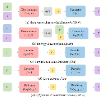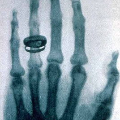Denoising diffusion models, a class of generative models, have garnered immense interest lately in various deep-learning problems. A diffusion probabilistic model defines a forward diffusion stage where the input data is gradually perturbed over several steps by adding Gaussian noise and then learns to reverse the diffusion process to retrieve the desired noise-free data from noisy data samples. Diffusion models are widely appreciated for their strong mode coverage and quality of the generated samples despite their known computational burdens. Capitalizing on the advances in computer vision, the field of medical imaging has also observed a growing interest in diffusion models. To help the researcher navigate this profusion, this survey intends to provide a comprehensive overview of diffusion models in the discipline of medical image analysis. Specifically, we introduce the solid theoretical foundation and fundamental concepts behind diffusion models and the three generic diffusion modelling frameworks: diffusion probabilistic models, noise-conditioned score networks, and stochastic differential equations. Then, we provide a systematic taxonomy of diffusion models in the medical domain and propose a multi-perspective categorization based on their application, imaging modality, organ of interest, and algorithms. To this end, we cover extensive applications of diffusion models in the medical domain. Furthermore, we emphasize the practical use case of some selected approaches, and then we discuss the limitations of the diffusion models in the medical domain and propose several directions to fulfill the demands of this field. Finally, we gather the overviewed studies with their available open-source implementations at https://github.com/amirhossein-kz/Awesome-Diffusion-Models-in-Medical-Imaging.
翻译:噪声扩散模型是一类生成模型,最近在各种深度学习问题中引起了极大的关注。扩散概率模型定义了一个前向扩散阶段,在几个步骤中逐渐添加高斯噪声扰动输入数据,然后学习反转扩散过程,从噪声数据样本中检索所需的无噪声数据。尽管已知计算负担,但广泛赞赏扩散模型具有强大的模式覆盖和生成样本的质量。借助于计算机视觉的进步,医学成像领域也对扩散模型产生了越来越多的兴趣。为了帮助研究人员浏览这个繁荣,本调查旨在提供医学图像分析学科中扩散模型的全面概述。
具体而言,我们介绍扩散模型的坚实理论基础和基本概念,以及三个通用扩散建模框架:扩散概率模型、噪声条件分数网络和随机微分方程。然后,我们根据其应用、成像模态、感兴趣的器官和算法,为医学领域的扩散模型提供系统的分类学。为此,我们涵盖了扩散模型在医学领域的广泛应用。此外,我们强调了一些选定方法的实际用例,然后讨论了扩散模型在医学领域的局限性,并提出了几个方向来满足该领域的需求。最后,我们将总结调查中研究的可用的开源实现,网址为 https://github.com/amirhossein-kz/Awesome-Diffusion-Models-in-Medical-Imaging。



